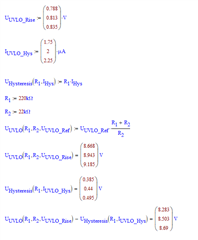Tool/software:
Hello,
I have replaced the resistor R8 with 220 k and R9 with 22k on the EVM. The measured switch on/off thresholds are:
|
Switch on |
8.891 V |
|
Switch off |
8.386 V |
|
Hysteresis |
0.505 V |
Using the formula in the data sheet, I expected the following threshold values. The on/off thresholds are OK, but the hysteresis is too high.
I have measured similar values on our assemblies. Can you please check whether my calculation approach is right.

Best regards,
Alexander



